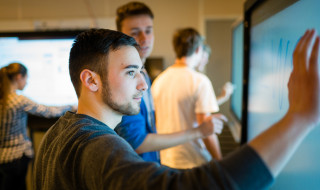Learning spaces properly support activational education and help students develop 21st century skills. The physical spaces offer extensive didactic opportunities, stimulate learning processes and are in some cases rich in technology. But how do you develop learning spaces? How do you ensure that they are used to their full potential?
Publications
Learning spaces are attracting increasing interest worldwide. In the Netherlands, many institutions are working on small-scale pilots and there is a clear need to exchange knowledge. SURF wants to provide more insight into the design of learning spaces for activating education.

"The layout of the university's teaching spaces was getting in my way more and more. My teaching style demanded a lot of interaction and much less one-way traffic. I had to do something with that." Jasper van Winden, lecturer at Utrecht University talks passionately about his initiatives to make teaching more interactive.
Publication Active learning spaces: lessons learned in the US

In this publication, you will read the key insights from the 2019 study trip to the US and what active learning spaces can mean for Dutch higher education.
6 lessons learned
- Put students at the centre when developing active learning spaces.
- Use active learning spaces to facilitate activating didactics.
- Use technology to constantly develop active learning spaces.
- Good supervision and training of lecturers is necessary to optimise the didactic use of active learning spaces.
- Ensure institutional-wide support for the successful implementation of active learning spaces.
- Cross-institutional cooperation pays off: learn from each other instead of reinventing the wheel yourself.
Also available in English.
Research on technology-rich learning spaces in Dutch higher education

In this issue, you will find results, conclusions and recommendations following a survey on the state of technology-rich learning spaces in Dutch higher education in 2019.
Multi-location learning in practice
Two real-life examples from KU Leuven and 4TU to show what is possible with multi-location learning. This is simultaneous teaching from different locations using a live connection.
Innovative lecture halls
There is an international movement to change traditional teaching spaces in higher education into spaces where active learning by students is encouraged. In the Netherlands, several concepts of collaborative teaching spaces have been realised for medium-sized groups (30-50 students). At the end of 2023, there appeared to be a need nationwide in the SURF Community Learning Spaces for an overview document on innovative lecture halls. In this document, Marij Veugelers shows what kind of developments are taking place internationally in the creation of innovative lecture halls. With here and there a side trip to an example in the Netherlands.
Study trip to ELI 2020
The highlight of this study tour was the visit to Oregon State University. In setting up their Learning Innovation Centre, they put their educational vision at the centre. This resulted in round lecture halls, for example. Read the report of the study tour.
Also read the comprehensive report to Oregon State University. This report has learning spaces as its focus.

Round lecture hall in the LINC at Oregon State University. Photo: Michel Jansen
Stakeholder analysis
The SIG Learning Spaces (2020) publication Stakeholder Analysis provides tools for identifying initial stakeholders. Use them as a tool to achieve your goal of engaging the right stakeholders in the right way and at the right time.
Increasing Lecturer Engagement for Innovative Teaching Spaces
The SIG Learning Spaces has produced a document to help you increase Lecturer Engagement for Innovative Teaching Spaces (2020).
Articles from the SURF Community Learning Spaces
On the Communities page of the SIG Learning Spaces, the SIG collects reports of events, links to studies and other resources. Here are some interesting articles.
Research
- Literature review synchronous hybrid learning: Synchronous learning is relatively new. Therefore, few studies have examined its use and effectiveness. This 2019 KU Leuven research has compiled the available global research into an overview regarding the benefits, challenges and current design principles to set up synchronous hybrid learning.
- TECOL report KU Leuven: Since 2016, KU Leuven has been engaged in a broad project involving multiple innovative teaching spaces and building expertise in teaching. This is the March 2020 report with all their findings.
- KU Leuven research publication: Research on Hybrid Virtual Classrooms, published in 2020 at Elsevier in Computers and Education.
- Teambase learning space from the AMC: Educational research by Jet Bierman (University of Amsterdam ) on the AMC's team-based learning space. This research provides insight into how the users of the space, students and lecturers, behave, what role the teaching space has in active learning and how technology relates to it.
- Research on teaching space of the future(Part 1 and Part 2): The research concluded that the quality of education is improved by driving the transition to active learning. In this blog post, we pitch four concepts that should contribute to this. Some concepts are not active learning-specific, but we believe they can contribute immensely within an active learning setting.
Examples of spaces
- Book on ateliers NHL Stenden: The book on NHL Stenden's ateliers was published in 2019. It gives an overview of all ateliers within the university of applied sciences and discusses the design process of an atelier, how the ateliers differ from each other and what place the atelier occupies in the DBE (Design Based Education) educational concept.
Reports of study days, conferences and Lectures
- Report on Making Learning Spaces Work (Utrecht University)
- Study trip 2020 SURF (USA; Oregon University)
- Report of opening day of PULS education building TU Delft
- Impression visit Adam Finkelstein to the Netherlands (2019)
- Summit Innovative learning spaces Barcelona (2019)
- Online conference ELI (2020)
- Reports of reports of 3 webinars from Indiana University with tips to get started yourself(1, 2, 3)
